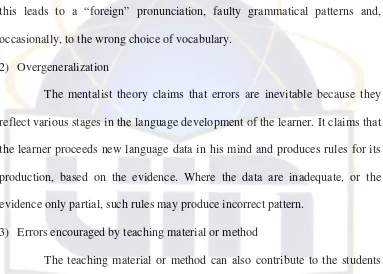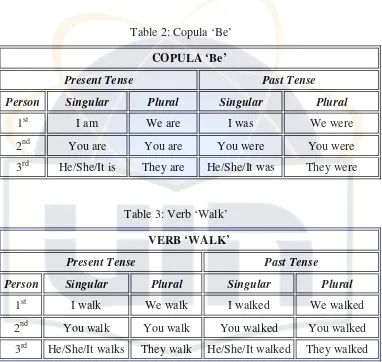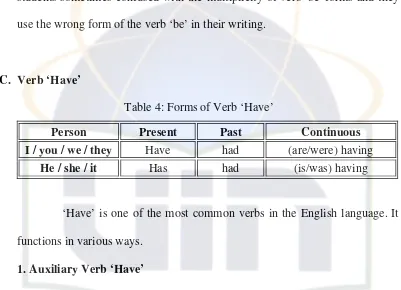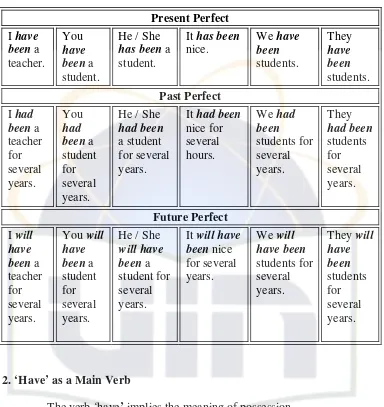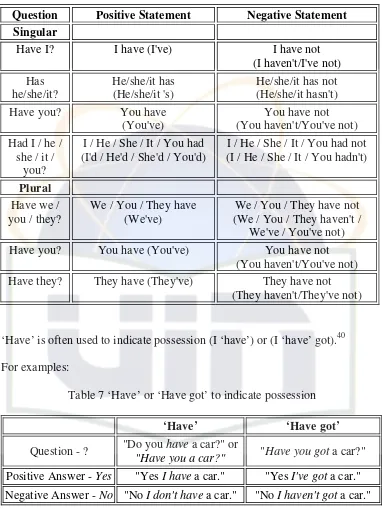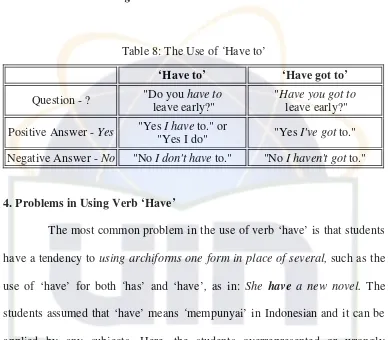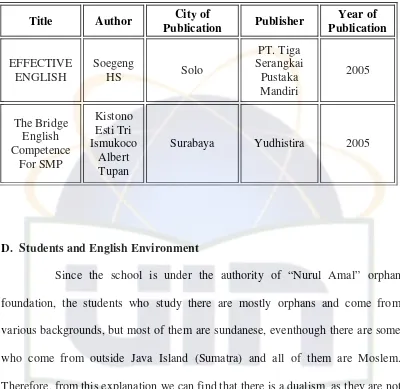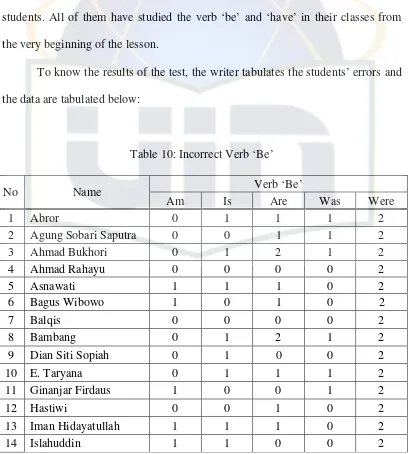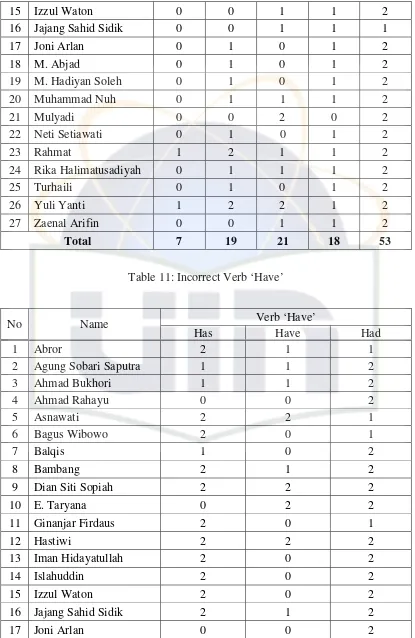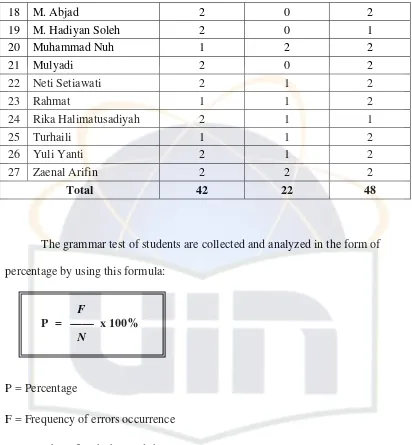STUDENTS’ ERRORS IN USING VERB ‘BE’ AND ‘HAVE’
(A Case Study on Students of ‘MTs. Nurul Amal’, Kramat Jati, East Jakarta)ERLANGGA BUDHI PATRIA NO. 103026027620
ENGLISH LETTERS DEPARTMENT
THE “ADAB” AND HUMANITIES FACULTY
STATE ISLAMIC UNIVERSITY
“SYARIF HIDAYATULLAH”
STUDENTS’ ERRORS IN USING VERB ‘BE’ AND ‘HAVE’
(A Case Study on Students of ‘MTs. Nurul Amal’, Kramat Jati, East Jakarta)A "Skripsi"
Submitted to the "Adab" and Humanities Faculty in Partial Fulfillment of the Requirements for
the Strata 1 (S1) Degree
ERLANGGA BUDHI PATRIA NO. 103026027620
ENGLISH LETTERS DEPARTMENT
THE "ADAB" AND HUMANITIES FACULTY
STATE ISLAMIC UNIVERSITY
"SYARIF HIDAYATULLAH"
APPROVEMENT
STUDENTS’ ERRORS IN USING VERB ‘BE’ AND ‘HAVE’
(A Case Study on Students of ‘MTs. Nurul Amal’, Kramat Jati, East Jakarta)A "Skripsi"
Submitted to the "Adab" and Humanities Faculty in Partial Fulfillment of the Requirements for
the Strata 1 (S1) Degree
ERLANGGA BUDHI PATRIA NO. 103026027620
ENGLISH LETTERS DEPARTMENT
THE "ADAB" AND HUMANITIES FACULTY
STATE ISLAMIC UNIVERSITY
"SYARIF HIDAYATULLAH"
ABSTRACT
Erlangga Budhi Patria, Students’ Errors in Using Verb ‘Be’ And ‘Have’ (A Case Study on Students of ‘MTs Nurul Amal’, Kramat Jati, East Jakarta). "Skripsi”: English Letters Department, The “Adab” and Humanities Faculty, State Islamic University Syarif Hidayatullah, 2008.
The main objective of this research is to know the common errors of using verb ‘be’ and ‘have’made by students of “MTs Nurul Amal”, Kramat Jati, East Jakarta in their writing test and also to find out the causes of those errors.
The method of the research is a qualitative method, the writer analyzed the students’ English writing test to know the types of errors the students did most in using verb ‘be’ and ‘have’ and to know the causes of those errors. Afterward, the writer described the number of errors in the table form as the recapitulation of the errors the students have made. The writer described the errors in each sentence and gave an analysis. The writer used a test as the instrument for collecting the data. For the test, the writer asked the students fifteen questions concerning with verb ‘be’ and verb ‘have’. The unit analysis of this research is 27 (twenty seven) papers of test result taken from all students of “MTs Nurul Amal”.
LEGALIZATION
The paper entitled “Students’ Errors in Using Verb ‘Be’ And ‘Have’ (A Case Study on Students of ‘MTs. Nurul Amal’, Kramat Jati, East Jakarta)” has been defended before the Adab and Humanities Faculty’s Examination committee on August 21 2008. The paper has already been accepted as a partial fulfillment of the requirements for the Strata 1 (S1) Degree.
Jakarta, August 21 2008
Examination Committee
Chair Person, Secretary,
Dr. Muhammad Farkhan, M.Pd. Drs. A. Saefuddin, M.Pd. NIP. 150 299 480 NIP. 150 261 902
Members:
Examiner I, Examiner II,
Drs. A. Saefuddin, M.Pd. Elve Oktafiyani, M.Hum. NIP. 150 261 902 NIP. 150 137 725
DECLARATION
I hereby declare that this submission is my own work and that, to the best of my knowledge and belief, it contains no material previously published or written by another person nor material which to a substantial extent has been accepted for the award of any other degree or diploma of the university or the other institute of higher learning, except where due acknowledgment has been made in the text.
Jakarta, August 21 2008
ACKNOWLEDGMENT
In the name of Allah, the Beneficent, the Merciful.
All praises due to Allah SWT, the Cherisher and Sustainer of the universe, who has
bestowed upon the writer completing this paper. Peace and salutation be upon our
prophet Muhammad SAW, who has saved the believers from destruction into safety
and has guided them to the right way of Islam.
In this opportunity, the writer would like to convey his heartfelt thanks to these amazing people, especially to Drs. Zainal Arifin Toy, M.Sc the writer’s advisor for his time, guidance and encouragement in correcting and helping him to finish this paper.
1. His beloved parent H. Riyanto and Elly Hertati, for their prayers, trust, affection, and support to the writer. They have been struggling and very patient to assist his education morally and materially until finishing this paper with their various ways, he conveys his truly grateful to have them
2. Dr. H. Abdul Chair, M.A., the Dean of Adab and Humanities Faculty
3. Dr. H. Muhammad Farkhan, M.Pd., the Head of English Letters Department, and Drs. A. Saefuddin, M.Pd., the Secretary of English Letters Department 4. All lecturers in English Letters Department, especially to Mr. Kyle Devlin
from USA, the greatest lecturer the writer ever had.
6. H. Hasan Sadili, S.S., the Principal of ‘MTs Nurul Amal’, H. EK. Zaenuddin, the Head of ‘Nurul Amal’ foundation and all teachers for giving the writer an opportunity to carry out the research.
7. All who have given their supports for the writer.
May Allah SWT, the all-Hearer and all-Knower, always bless you all and gives you more than what you have done to the writer.
Jakarta, July 2008
TABLE OF CONTENTS
CHAPTER II. THEORETICAL FRAMEWORK ... 7
3. The Use of ‘Haveto’ ... 23
4. Problems in Using Verb ‘Have’... 23
CHAPTER III. PROFILE OF “MTS NURUL AMAL” JAKARTA.. 24
A. The English Curriculum ... 24
B. English Teaching Methods ... 25
C. The English Textbooks Used in the School ... 25
D. Students and English Environment ... 26
CHAPTER IV. RESEARCH FINDINGS ... 27
A. Data Description ... 27
B. Data Analysis and Error Causes ... 31
CHAPTER V. CONCLUSIONS AND SUGGESTIONS ... 52
A. Conclusions ... 52
B. Suggestions ... 53
BIBLIOGRAPHY ... 54
LIST OF TABLES
1. Forms of Verb ‘Be’ ... 15
2. Copula ‘Be’ ... 18
3. Verb ‘Walk’ ... 18
4. Forms of Verb ‘Have’ ... 20
5. Auxiliary Verb ‘Have’ ... 21
6. ‘Have’ as a Main Verb ... 22
7. ‘Have’ or ‘Have got’ to indicate possession ... 22
8. The Use of ‘Haveto’ ... 23
9. The English Textbooks used in the “MTs. Nurul Amal” ... 26
10. Incorrect Verb ‘Be’ ... 27
11. Incorrect Verb ‘Have’ ... 28
12. The Percentage of Verb ’Be’ Errors ... 30
13. The Percentage of Verb ‘Have’ Errors ... 30
14. The Percentage of Total Errors ... 30
CHAPTER I INTRODUCTION
A. The Background of Research
English is, of course, only one of the many languages, perhaps as many as three thousand, which are spoken today.1 As an international language, it has an important role in the world. English is spoken almost by all people around the world as their mother tongue or second language.
In Indonesia, English is studied and becomes one of the subject matters taught at school. Since 1994, English has been decided as one of the local-content subject at the elementary school in the fourth, fifth and sixth year.2 It is considered as the first foreign language and becomes a compulsory subject learned by students from the elementary school up to the university.3
Learning English is mastering the four basic skills of English, namely: listening, speaking, reading, and writing. The last basic skill (writing) is considered as the most difficult one, because it needs hard thinking and takes many years of extensive study to write correctly. Writing is not such a simple process, even professional writers write, rewrite, review and revise because it takes
1
W. Nelson Francis, The English Language An Introduction, (New York: W.W Norton & Company. NC, 1965), p.1
2
Anonymous, Kurikulum Muatan Lokal untuk Sekolah Dasar, (Jakarta: Depdikbud, 1994), p.30
3
Anonymous,"Pembelajaran Bahasa Inggris Perlu Diperbarui", Kedaulatan Rakyat,
many attempts to produce the perfect, finished copy that clearly communicates their ideas.4
Most of schools emphasize grammar and speaking skill in teaching English but it was rarely to teach the class writing skill. Generally, the students are demanded to understand and memorize the formulas of structure or grammar but they cannot apply them in writing. This becomes one of problems in writing. Some students may have high score in grammar but they cannot use it in writing. In fact, writing is also important in the process of language learning. Through writing, the students learn how to think and use their imaginations, they can write their ideas, opinions and whatever they want without interfering with others.
Writing skill is very complex and difficult to teach. In writing, students often find some difficulties. Many of them have no idea to write. Even tough most of students commonly make mistakes, but they are logically acceptable.
In this research, writer tries to analyze the use of grammar by learners of English as foreign language. Specifically, this is to identify the errors in the use of verb ‘be’ and ‘have’ made by students of “MTs. Nurul Amal”, Kramat Jati, East Jakarta.
The verb ‘be’ and ‘have’ usually come up to the students from the very beginning of the lesson. Students in the beginning level have usually got used to make use of this material since the verb ‘be’ and ‘have’ is quite dominant in the early stage of sentence constructions.
4
The students of "MTs Nurul Amal" have difficulties in producing a grammatically correct sentence, especially in verb 'be' and 'have', because the verb 'be' and 'have' are not found in the students' mother tongue (Indonesian), and it is different from Indonesian verb in which tenses are not found. The most common problem of using verb ‘be’ is that students sometimes confused with the multiplicity of verb 'be' forms and they use the wrong form of the verb ‘be’in their writing. On the other hand, the most common problem in the use of verb ‘have’is that students have a tendency to use verb ‘have’for both ‘has’ and ‘have’.
Considering the benefit of errors recognition as a mean of improving students’ comprehension to the language, the writer intends to carry out a discussion on error analysis in the use of the verb ‘be’ and ‘have’.
B. The Limitation of Problem
The writer focuses this research on analyzing the errors made by the students of “MTs. Nurul Amal”, Kramat Jati, East Jakarta in the use of verb ‘be’ and ‘have’ and also finding out the causes of those errors.
C. The Questions of Research
Based on the background of the research and the limitation of the problem, the writer formulates the research questions as follow:
1. What kinds of errors do students commonly make in using verb ‘be’ and ‘have’?
D. The Objective of Research
The objective of this research is to know the common errors of using verb ‘be’ and ‘have’ made by students in their writing. Theoretically, this research intends to identify, define, classify, and then finally explain the errors.
E. The Significance of Research
By analyzing the students’ errors in writing using the verb ‘be’ and ‘have’, the writer hopes the result of this research would be advantageous for the readers who like writing in order they can anticipate errors in their writing and as motivation for the students to make good writing and to know the importance of writing in language learning process. It is also used as inputs for the writer to identify what problems are found difficult in applying the verb ‘be’ and ‘have’ by the students.
F. Research Methodology 1. The Objective of Research
The objective of this research is to know the common errors of using verb ‘be’ and ‘have’ made by students of “MTs Nurul Amal”, Kramat Jati, East Jakarta in their writing. Theoretically, this research intends to identify, to define, to classify, and then finally to explain the causes of errors.
In this research, the writer uses the qualitative method where he analyzes the students’ English writing to know the types of errors the students do most in their writing in using verb ‘be’ and ‘have’ and to know the causes of those errors. After that, the writer describes the number of errors in the table form as the recapitulation of the errors the students have made. The writer will describe the errors in each sentence and give an analysis.
3. The Instrument of Research
The writer uses a test as the instrument for collecting the data. For the test, the writer asked the students fifteen questions concerning with verb ‘be’ and ‘have’.
4. The Technique of Data Analysis
For this research, the writer analyzes each student’s writing, finds out, and classifies the errors he/she made, and lists them in form of tables. Then, from those errors, the writer concludes what the causes of those errors are.
5. The Unit of Analysis
The unit analysis of this research is the result of verb ‘be’ and ‘have’ test from students of “MTs Nurul Amal”, Kramat Jati, East Jakarta.
The writer chooses all students of “MTs Nurul Amal”, Kramat Jati, East Jakarta, since there are only twenty seven students that divided into three classes; Class VII: twelve students, Class VIII: seven students, and Class IX: eight students. Then, the students will sign the written test.
7. The Place and Time of Research
CHAPTER II
THEORETICAL FRAMEWORK
A. Error and Error Analysis 1. The Definition of Error
According to Hornby in Oxford Advanced Learner’s Dictionary, error is a thing done wrongly or mistake.5 On the contrary, in the study of Error Analysis, experts distinguish error from mistake. Errors are caused by lack of knowledge about the target language or by incorrect hypothesis about it. Errors are a noticeable and cannot be self-corrected. They are deviations from the adult grammar of a native speaker, and reflect the competence of the learner. Errors reveal the portion of the learner’s competence in the target language.6
Mistakes are caused by temporary lapses of memory, confusion, slips of the tongue and so on.7 A mistake refers to a performance error that is either a random guess or a ‘slip’. It is the result of some sort temporary breakdown or imperfection in the process of producing speech. And when attention is called to it, mistake can be self-corrected.8 Julian Edge, in Harmer (2001), suggests that we can divide mistake into two broad categories: ‘slip’ and ‘attempts’.
5
A S Hornby, Oxford Advanced Learner’s Dictionary, (New York: Oxford University Press, 1995), p.390.
6
H. Douglas Brown, Principle of Language Learning and Teaching, (New York: Prentice Hall Regents, 1987), p.217.
7
Peter Hubbard et.al., A Training Course for TEFL, (New York: Oxford University Press, 1983), p.134.
8
Slips are mistakes which students can correct themselves and which therefore need explanation, while attempts are mistakes committed when students try to say something but do not yet know the correct way of saying it.9
There are distinguished types of errors the learners made, among the most common errors are:
a. Omitting grammatical morphemes, which are items that do not contribute much to do meaning of sentences, as in He hit car. b. Double marking a semantic feature (e.g. past tense) when only
one marker is required, as in She didn’t went back.
c. Regularizing rules, as in womans for women.
d. Using archiforms -one form in place of several-such as the use of
her for both she and her, as in I see her yesterday.Her dance with my brother.
e. Using two or more forms in random alternation even though the language requires the use of each only under certain conditions, as in the random use of he and she regardless of the gender of the person of interest.
f. Misordering items in constructions that require a reversal of word-order rules that had been previously acquired as in What you are doing?, or misplacing items that may be correctly placed
9
in more than one place in the sentence, as in: They are all the time late.10
Corder (1967) noted that errors could be significant in three ways: (1) they provided the teacher with information about how much the learner had learnt, (2) they provided the researcher with evidence of how language was learnt, and (3) they served as devices by which the learner discovered the rules of the target language.11
2. Error Analysis
Making errors is human being and natural; as natural as the movement of the sun and the moon. In learning process, errors have been perceived as a device a learner uses in order to learn. Indeed, human learning is fundamentally a process that involves the making of mistakes. Mistakes, misjudgment, miscalculation, and erroneous assumption form an important aspect of learning virtually any skill or acquiring information.12 In 1994, Gass and Selinker defined errors as ‘red flags’ that provide evidence of the learner’s knowledge of the second language.13
10
Heidi Dulay et.al., Language Two, (New York: Oxford University Press, 1982), p.138-139
11
For some researchers, errors are valuable for they contain information on the strategies that people use to acquire a language.14 This positive perception of errors can be traced back to the article entitled ‘The Significance of Learner errors’ written by the ‘father’ of Error Analysis, Pit Corder, in 1967. Errors used to be ‘flaws’ that are needed to be eradicated. Corder presented a completely different point of view. He contended that those errors are ‘important in and of themselves’.
According to Harimurti Kridalaksana, Error Analysis is a technique to measure the progress of language learning by marking and classifying the errors committed by someone or a group. “Analisis kesilapan: Teknik untuk mengukur kemajuan belajar bahasa dengan mencatat dan mengklasifikasikan
kesalahan-kesalahan yang dibuat oleh seseorang atau kelompok”.15
Error Analysis is a process based on analysis of learner’s error in the process of second language learning. Sharma stated: error analysis is defined as a process based on analysis of learner’s with one clear objective; evolving a suitable and effective teaching learning strategy and remedial measures necessary in certain clearly marked out areas of the foreign language.16
Error Analysis (EA) was born in 1967 initiated by Pit Corder to challenge the behaviorists’ theory on learner’s error, i.e. contrastive analysis
14
Dulay et.al. (1982), op.cit., p.138
15
Harimurti Kridalaksana, Kamus Linguistik, (Jakarta: PT. Gramedia, 1982) p.11
16
(CA).17 The CA treatment of errors rested on comparison of the learner’s native and target languages. Differences between the two were thought to account for the majority of an L2 learner’s errors. The behaviorist view of learning at that time provided the theoretical justification for CA. It held that learning was basically a process of forming automatic habits and that errors should therefore result from first language habits interfering with the learner’s attempts to learn new linguistics behaviors. It was thought that contrastive analysis of the learner’s two languages would predict the areas in the target language that would pose the most difficulty.18
Attentive teachers and researchers, however, noticed that a great number of student errors could not possibly be traced to their native language.19 Error analysis emphasizes the significance of errors in learners’
‘interlanguage’ system.20 The term interlanguage refers to the systematic knowledge of an L2 which is independent of both learner’s L1 and the target language. It is the separateness of a second language learner’s system, a system that has structurally intermediate status between the native and target language.21 Error analysis became distinguished from contrastive analysis by
17
Dulay (1982), op.cit., p.140
18ibid.
19
ibid.
20ibid.
21
its examination of errors attributable of all possible sources, not just those resulting from negative transfers of the native language.22
Studying learners’ errors serves two major purposes: (1) It provides data from which inferences about the nature of the language learning process can be made; (2) It indicates to teachers and curriculum developers which part of the target language students have most difficulty producing correctly and which error types detract most from a learner’s ability to communicate effectively.23
3. Model for Error Analysis
In the process, error analysis will require researchers to use certain methodology. Corder identified a model for error analysis which includes three stages:
1) Data collection: recognition of idiosyncrasy 2) Description: accounting for idiosyncratic dialect 3) Explanation (the ultimate object of error analysis).24
Hubbard gave practical advice and provided clear examples of how to identify and analyze learners’ errors. The initial step requires the selection of a corpus of language followed by the identification of errors. The errors then
22
ibid., p.218
23
Dulay (1982), op.cit., p.138
24
classified. The next step, after giving a grammatical analysis of each error, demands an explanation of different types of errors.25
Moreover, Gass & Selinker identified 6 steps followed in conducting an error analysis: collecting data, identifying errors, classifying errors, quantifying errors, analyzing source of errors, and remediating for errors.26
4. Sources of Error
The final step in the analysis of erroneous learner production is that of determining the source of error. By trying to understand sources we can take another step toward understanding how the learner’s cognitive and affective processes relate to the linguistic system and to formulate an integrated understanding of the process of the second language acquisition.27
Errors -overt manifestation of learner’s system- arise from possible general sources: interlingual errors within the target language, the sociolinguistic context of communication, psycholinguistic or cognitive strategies, and countless affective variables.28
Pit Corder (in Hubbard, 1983) claims that there are three major causes of error, which he labels ‘transfer errors’, ‘analogical errors’, and
‘teaching-induced errors’. While Hubbard proposed a slightly different names;
25
Hubbard (1983), op.cit., p.135-141
1) Mother-tongue interference
Although young children appear to be able to learn a foreign language quite easily and to reproduce new sounds very effectively, older learners experience considerable difficulty. The sound system (phonology) and the grammar of the first language impose themselves on the new language and this leads to a “foreign” pronunciation, faulty grammatical patterns and, occasionally, to the wrong choice of vocabulary.
2) Overgeneralization
The mentalist theory claims that errors are inevitable because they reflect various stages in the language development of the learner. It claims that the learner proceeds new language data in his mind and produces rules for its production, based on the evidence. Where the data are inadequate, or the evidence only partial, such rules may produce incorrect pattern.
3) Errors encouraged by teaching material or method
The teaching material or method can also contribute to the students errors. Unfortunately, these errors are much more difficult to classify, as Pit Corder admits this: “It is, however, now easy to identify such errors except in conjunction with a close study of the materials and teaching techniques to which the learner has been exposed. This is probably why so little is known about them.”29
B. Verb ‘Be’
Table 1: Forms of Verb ‘Be’
29
Person Present Past
I Am Was
he / she / it Is Was
you / we / they Are Were
The verb in English has traditionally been defined as a word that “express action or a state of being.” This definition is not very useful, however, because other words, especially nouns and adjectives, can also express these meanings. Modern grammarians prefer to define word classes on the basis of their form, insofar as this is possible, and then according to their use in sentences.30 One of those is the verb ‘be’ that has posed a quite frequent error to students of ESL/EFL.
Indonesian students are exposed to the forms of the verb ‘be’ almost immediately in their earliest English classes or in any English-speaking environment they might be experiencing. The forms are superficially simple to describe and understand, yet they pose problems for learners at all level. ‘Be’ poses the greatest problems at the initial stage.
‘Be’ function as an auxiliary verb as well as a copula. The auxiliary verb is also called verb-like words or ‘helping’ words since they have quite different rules of usage from those having to do with verbs.31 They combine with verbs in order to express many important meanings, yet we do not call them true verb. The copula, on the other hand, links nonverbal predicates (i.e.,
30
English Language Service, Inc., The Key to English, (New York: Macmillan Publishing, 1964) p.iii
31
nouns, adjectives, and certain adverbials) with their subjects and serves as a carrier for tense and subject-verb agreement.32
a student
Copula: Mike is clever
in Jakarta
Auxiliary: Mike is studying English in the class (progressive aspect)
1. Auxiliary Verb ‘Be’
The oxford dictionary of English Grammar define auxiliary verb as a verb used in forming tenses, moods, and voices of other verbs. There are four characteristics of English auxiliary verbs that distinguish them from true or full verbs; called NICE properties. NICE is an acronym stands for:
Negation : auxiliaries add not or –n’t directly to the verb form (e.g. don’t, can’t, cannot)
Inversion : they invert with the subject in questions (e.g. May I go now?)
Code : they can be used to avoid repetition of the whole verb phrase (e.g. I love going to concerts, and so does Jane)
Emphasis : auxiliaries can be used for emphasis (e.g. We will help you, I do remember).33
32
Marianne Celce-Murcia and Diane Larsen-Freeman, The Grammar Book, Second Edition, (United Stated: Heinle & Heinle, 1999), p.53
33
Auxiliary ‘be’ always occurs in conjunction with another verb, and it is thus referred to as an auxiliary verb. As an auxiliary verb, ‘be’ is used in progressive verb tenses.34 For example:
a) Rose is writing a letter - present progressive b) The student were listening to the music - past progressive
‘Be’ is also an auxiliary element in the passive voice and in a number of phrasal modals. In the passive, ‘be’becomes the prototypical passive verb. It is unmarked and thus semantically neutral.35
a) Diamonds were mined in South Africa - passive
b) She is going to go to USA tomorrow - with phrasal modal
2. Copula Verb ‘Be’
We use a special kind of verb to join an adjective or noun complement to a subject. These verbs can be called ‘copulas’ or ‘copular verb’. Common copular verbs are: be, seem, appear, look, sound, smell, taste, feel, become, and get.36
The copula ‘be’ is different from other copulas. The rule for expanding the verb phrase makes a clear distinction between copular verbs like ‘be’ and other verbs in English. Celce-Murcia and Freeman (1999) suggest four reasons for making such a distinction. First of all, ‘be’ which is the most
34
Betty Schrampfer Azar, Understanding and Using English Grammar, third edition,
(New York: Longman, 2002) p.A-6
35
Celce-Murcia (1999), op.cit., p.348
36
frequent verb in English, has more distinct forms with respect to person, number and tense than any other verb in English. The traditional paradigm for ‘be’compared with that for a lexical verb such as ‘walk’ makes this clear:
Table 2: Copula ‘Be’ COPULA ‘Be’
Present Tense Past Tense
Person Singular Plural Singular Plural
1st I am We are I was We were
2nd You are You are You were You were 3rd He/She/It is They are He/She/It was They were
Table 3: Verb ‘Walk’ VERB ‘WALK’
Present Tense Past Tense
Person Singular Plural Singular Plural
1st I walk We walk I walked We walked 2nd You walk You walk You walked You walked 3rd He/She/It walks They walk He/She/It walked They walked
A verb like ‘walk’ has two present-tense forms and one past-tense form. The verb ‘be’ on the other hand, has three distinct present-tense forms and two past-tense forms.
neutral copula. ‘be’ can also be followed by noun phrases and adverbial prepositional phrases (i.e., it is the grammatically most flexible copular verb):
attractive
Alice is an actress
in London
Third, the syntactic behavior of the copula ‘be’, which behaves like an auxiliary verb and has operator function with regard to question formation, negation, and other constructions, is very different from that of other verbs like ‘walk’or other copular verbs, which require the addition of a ‘do’ auxiliary as the operator if no other auxiliary verb is present.
Finally, the copula ‘be’ does not occur in all languages, but all languages have verbs. Especially in the present tense, many languages have nothing equivalent to the copula ‘be’.
In sum, a verb is copular if it is followed by a noun phrases, an adjective phrase, or an adverbial that specifically predicates something about the subject of the verb.37
3. Problems in Using Verb ‘Be’
The most common problem in the use of verb ‘be’ is that students have a tendency to omit it. Second language learners have been observed to omit the copula regardless of whether or not their native language has an equivalent form. For those students whose native language no copula, this initial tendency will be even more pronounced. The other problem involves use
37
of wrong form of ‘be’. The multiplicity of forms explains why learners sometimes use the wrong form of the verb ‘be’in their speech or writing.38
The verb 'be' is not found in the students' mother tongue (Indonesian), and it is different from Indonesian verb in which tenses are not found. The students sometimes confused with the multiplicity of verb 'be' forms and they use the wrong form of the verb ‘be’in their writing.
C. Verb ‘Have’
Table 4: Forms of Verb ‘Have’
Person Present Past Continuous
I / you / we / they Have had (are/were) having
He / she / it Has had (is/was) having
‘Have’ is one of the most common verbs in the English language. It functions in various ways.
1. Auxiliary Verb ‘Have’
The verb “to have” is used as an auxiliary verb to help other verbs create the perfect tense - auxiliary verb have [+ past participle].39
For example: I havestudied English for five years I have never been to America
I haveeaten
38ibid.
39
Table 5: Auxiliary Verb ‘Have’
The verb ‘have’implies the meaning of possession.
For example: “I have a job”, “I have a car“ or "I don't have any time."
In this form it does not take the continuous form (for that we have to use the auxiliary verb ‘be’).
For example: “I amhaving a shower” or “Are you having a good time?"
The forms of the verb ‘have’ are ‘have’ and ‘has’ for the present and
‘had’ for the past.
Question Positive Statement Negative Statement Have they? They have (They've) They have not
(They haven't/They've not)
‘Have’ is often used to indicate possession (I ‘have’) or (I ‘have’ got).40 For examples:
Table 7 ‘Have’ or ‘Have got’ to indicate possession
‘Have’ ‘Have got’
In addition to the two forms, there is another use for have as a modal verb; have to or have got to. This, of course, must be followed by another verb
"We have to dosomething".
Table 8: The Use of ‘Haveto’
‘Have to’ ‘Have got to’ Question - ? "Do you have to
leave early?"
"Have you got to
leave early?" Positive Answer - Yes "Yes Ihave to." or
"Yes I do" "Yes I've got to." Negative Answer - No "No I don't have to." "No I haven't got to."
4. Problems in Using Verb ‘Have’
The most common problem in the use of verb ‘have’ is that students have a tendency to using archiforms one form in place of several, such as the use of ‘have’ for both ‘has’ and ‘have’, as in: She have a new novel. The students assumed that ‘have’ means ‘mempunyai’ in Indonesian and it can be applied by any subjects. Here, the students overrepresented or wrongly assumed ‘have’ at the same time he/she underrepresented ‘has’.
CHAPTER III
PROFILE OF “MTS NURUL AMAL” JAKARTA
In this chapter, the writer will give a brief explanation about “MTS NURUL AMAL” JAKARTA, namely:
1) Name of school : Madrasah Tsanawiyah Nurul Amal Jakarta Timur
2) School address : Jl. Amil Wahab Rt. 004/ 09 No. 45 Kramat Jati, Jakarta Timur 13510
3) Telephone Number : (021) 8002417 4) Statistic Number : 212317212001 5) Year of Establishment : 2004
6) Head Master : H. Hasan Sadili, S.S. 7) Accreditation school : Private Islamic School
8) Size : ± 500 m2
(see the appendix for more details)
A. The English Curriculum
B. English Teaching Methods
The English teaching learning process in this school uses Contextual Teaching and Learning (CTL) approach, this approach is a study concept that helps teacher connects subject -which is taught- with the student’s reality life. In this contextual class, the role of the teacher is helping students to reach their purposes. It means the teachers mostly deal with the strategy than giving information. The teacher’s duty is to develop class as a team that work together to find something new (innovation) for the class members (students). Here, the learning strategy is more important than the result.41
C. The English Textbooks used in The School
The English teaching learning process needs a textbook. It is one of the most important instruments because it can guide the teacher to explain the lesson according to syllabus. A textbook is a book designed to be used in the class. It is accurately arranged and prepared by the experts and completed with appropriate teaching equipments based on the following state that the textbook is used to help teachers in teaching learning process. By using textbook, the teaching learning goals can be reached. It is very useful if the teachers use textbook in their teaching. The English textbooks can support the teaching learning process.
41
Table 9: The English Textbooks used in “MTs Nurul Amal”
D. Students and English Environment
Since the school is under the authority of “Nurul Amal” orphan foundation, the students who study there are mostly orphans and come from various backgrounds, but most of them are sundanese, eventhough there are some who come from outside Java Island (Sumatra) and all of them are Moslem. Therefore, from this explanation we can find that there is a dualism, as they are not only student, but also ‘santri’ of “Nurul Amal” foundation.
In this foundation, all of students are obliged to speak both English and Arabic in their daily conversation. This environment is, of course, very conducive for them to improve their English skills. So, the English teaching learning process is not only held in the class, but also after class.
CHAPTER IV RESEARCH FINDINGS
A. Data Description
The sample students are taken from all students of “MTs Nurul Amal”, Kramat Jati, East Jakarta. There are twenty seven students that divided into three classes; Class VII: twelve students, Class VIII: seven students, and Class IX: eight students. All of them have studied the verb ‘be’ and ‘have’ in their classes from the very beginning of the lesson.
To know the results of the test, the writer tabulates the students’ errors and the data are tabulated below:
15 Izzul Waton 0 0 1 1 2
Table 11: Incorrect Verb ‘Have’
18 M. Abjad 2 0 2
19 M. Hadiyan Soleh 2 0 1
20 Muhammad Nuh 1 2 2
21 Mulyadi 2 0 2
22 Neti Setiawati 2 1 2
23 Rahmat 1 1 2
24 Rika Halimatusadiyah 2 1 1
25 Turhaili 1 1 2
26 Yuli Yanti 2 1 2
27 Zaenal Arifin 2 2 2
Total 42 22 48
The grammar test of students are collected and analyzed in the form of percentage by using this formula:
F
P = —— x 100%
N
P = Percentage
F = Frequency of errors occurrence N = Number of verb ‘be’and ‘have’
Table 12: The Percentage of Verb ’Be’ Errors
Verb ‘Be’ Number of Verb ‘Be’ Frequency of Errors Occurrence Percentage
Am 54 7 3 %
Is 54 19 8 %
Are 54 21 9 %
Was 27 18 7 %
Were 54 53 21 %
Total 243 118 48 %
Table 13: The Percentage of Verb ‘Have’ Errors
Verb ‘Have’ Number of Verb ‘Have’
Frequency of
Errors Occurrence Percentage
Has 54 42 26 %
Have 54 22 14 %
Had 54 28 17 %
Total 162 92 57 %
Table 14: The Percentage of Total Errors
Kinds of Verb Number of Each Verb
Frequency of
Errors Occurrence Percentage
Verb ‘Be’ 243 118 29 %
Verb ‘Have’ 162 92 23 %
Total 405 210 52 %
B. Data Analysis and Error Causes
After tabulating the data, the writer finds the percentage of total errors is 52% (210 verbs ‘be’ and ‘have’ are written wrongly by the twenty seven students). The incorrect verbs consist of 29% (118 verbs ‘be’)and 23% (92 verbs ‘have’). It means that the students of this research write 48% (125 verbs ‘be’ and 70 verbs ‘have’) correctly.
In this analysis the writer will focus on the erroneous verbs ‘be’ whether in using “am, is, are, was, or were”, and also verbs ‘have’ whether in using “has, have, or had”. Then, the analysis of error causes can be described as follows:
1. Am
a). I … very happy today
From the text above, the writer finds out that there is a case of error on this problem. Here is the example:
1) I was very happy today
have verb ‘be’ like English. Then, the right sentence should be “I am very happy today”
b). She knows who I …
From the text above, the writer finds out that there are two cases of errors on this problem. Here are the examples:
1) She knows who I was
¾ The sentence above is the example of errors on point of view-verbs and all errors made by the students on this problem are caused by Mother Tongue Interference because the students are inconsistent in using the tense. This is a normal problem since there is no tense in Indonesian. The students have no idea that ‘was’ is not the same as ‘am’, since Indonesian does not have verb ‘be’ like English. Then the right sentence should be “She knows who I am”
2) She knows who I were
¾ The sentence above is the example of errors on point of view-verbs and all errors made by the students on this problem are caused by Mother Tongue Interference because the students are inconsistent in using the tense. This is a normal problem since there is no tense in Indonesian. The students have no idea about Subject-Verb Agreement’s rule that ‘am’must agree with ‘I’. Then the right sentence should be “She knows who I am”
a). Rakha … studying English in the class right now
From the text above, the writer finds out that there are two cases of errors on this problem. Here are the examples:
1) Rakha are studying English in the class right now
¾ The sentence above is the example of errors on Agreement-modified subject and verbs and all errors made by the students on this problem are caused by Mother Tongue Interference because there is no agreement between modified subject and verb in Indonesian. The students wrote the plural verb ‘are’ for the third singular subject ‘Rakha’. The student tried grasping the English form in singular verb ‘is’ form but he/she ‘half knew’ English rule for Subject-Verb Agreement’s rule that ‘is’must agree with singular subject (in this case, ‘Rakha’). Here, he/she overrepresented or wrongly assumed ‘are’ at the same time he/she underrepresented ‘is’. Then the right sentence should be “Rakha is studying English in the class right now”
2) Rakha was studying English in the class right now
Then the right sentence should be “Rakha is studying English in the class right now”
b). This message … for you
From the text above, the writer finds out that there are three cases of errors on this problem. Here are the examples:
1) This message are for you
¾ The sentence above is the example of errors on Agreement-modified subject and verbs and all errors made by the students on this problem are caused by Mother Tongue Interference because there is no agreement between modified subject and verb in Indonesian. The students wrote the plural verb ‘are’ for the modified subject ‘This message’. The student tried grasping the English form in singular verb ‘is’ form but he/she ‘half knew’ English rule for Subject-Verb Agreement’s rule that ‘is’ must agree with ‘This’, as ‘are’ must agree with ‘these’. Here, he/she overrepresented or wrongly assumed ‘are’ at the same time he/she underrepresented ‘is’. Then the right sentence should be “This message is for you”
2) This message were for you
agreement between modified subject and verb in Indonesian. Then the right sentence should be “This message is for you”
3) This message has for you
3) Are
a). The children … playing football in the square
From the text above, the writer finds out that there are three cases of errors on this problem. Here are the examples:
1) The children is playing football in the square
¾ The sentence above is the example of errors on Agreement-modified subject and verbs and all errors made by the students on this problem are caused by Mother Tongue Interference because there is no agreement between modified subject and verb in Indonesian. The students wrote the singular verb ‘is’ for the third plural subject ‘The children’. They have no idea that ‘The children’ is a plural form of ‘child’ and according to English rule for Subject-Verb Agreement, ‘the children’ must agree with ‘are’. Here, he/she overrepresented or wrongly assumed ‘is’ at the same time he/she underrepresented ‘are’. Then the right sentence should be “The children are playing football in the square”
2) Thechildren was playing football in the square
underrepresented ‘are’. Then the right sentence should be “The children are playing football in the square”
3) Thechildren have playing football in the square
¾ The sentence above is the example of errors on Agreement-modified subject and verbs and all errors made by the students on this problem are caused by Mother Tongue Interference because there is no agreement between modified subject and verb in Indonesian. The students overrepresented or wrongly assumed ‘have’ at the same time he/she underrepresented ‘are’. Then the right sentence should be “The children are playing football in the square”
b). There … four seasons in a year
From the text above, the writer finds out that there are three cases of errors on this problem. Here are the examples:
1) There is four seasons in a year
2) There has four seasons in a year
¾ The sentences above is the example of errors on Agreement-verb-subject order and all errors made by the students on this problem are caused by Mother Tongue Interference because there is no agreement between verb and subject order in Indonesian. In this case, ‘four seasons’ must agree with ‘there are’. The students overrepresented or wrongly assumed ‘has’at the same time he/she underrepresented ‘are’. Then the right sentence should be “There are four seasons in a year”
3) There have four seasons in a year
¾ The sentences above is the example of errors on Agreement-verb-subject order and all errors made by the students on this problem are caused by Mother Tongue Interference because there is no agreement between verb and subject order in Indonesian. In this case, ‘four seasons’ must agree with ‘there are’. The students overrepresented or wrongly assumed ‘have’ at the same time he/she underrepresented ‘are’. Then the right sentence should be “There are four seasons in a year”
4) Was
a). Syarifa … not tired last night
From the text above, the writer finds out that there are two cases of errors on this problem. Here are the examples:
¾ The sentence above is the example of errors on point of view-verbsand adverbs and all errors made by the students on this problem are caused by Mother Tongue Interference because the adverb disagrees with the verb. This is a normal problem since there is no agreement between verb and adverb in Indonesian. The students think that ‘is’ and ‘was’ are the same and can be applied in any adverb, because Indonesian does not have verb ‘be’ like English. He/she overrepresented or wrongly assumed ‘is’ at the same time he/she underrepresented ‘was’. Then the right sentence should be “Syarifa was not tired last night”
2) Syarifa are not tired last night
¾ The sentence above is the example of errors on Agreement-modified subject and verbs and all errors made by the students on this problem are caused by Mother Tongue Interference because there is no agreement between modified subject and verb in Indonesian. The students wrote the plural verb ‘are’ for the third singular subject ‘Syarifa’. Here, he/she overrepresented or wrongly assumed ‘are’ at the same time he/she underrepresented ‘was’. Then the right sentence should be “Syarifa was not tired last night”
5) Were
a). The men … doctors in “Harapan Bunda” hospital
From the text above, the writer finds out that there are two cases of errors on this problem. Here are the examples:
¾ The sentence above is the example of errors on Agreement-modified subject and verbs and all errors made by the students on this problem are caused by Mother Tongue Interference because there is no agreement between modified subject and verb in Indonesian. The students wrote the singular verb ‘is’ for the third plural subject ‘The men’. They have no idea that ‘The men’ is a plural form of ‘man’ and according to English rule for Subject-Verb Agreement, ‘The men’ must agree with ‘are’ or ‘were’. Here, he/she overrepresented or wrongly assumed ‘is’ at the same time he/she underrepresented ‘were’. Then the right sentence should be “The men were doctors in “Harapan Bunda” hospital”
2) The men was doctors in “Harapan Bunda” hospital
b). We … good friends for many years
From the text above, the writer finds out that there are two cases of errors on this problem. Here are the examples:
1) We are good friends for many years
¾ The sentence above is the example of errors on point of view-verbsand adverbs and all errors made by the students on this problem are caused by Mother Tongue Interference because the adverb disagrees with the verb. This is a normal problem since there is no agreement between verb and adverb in Indonesian. The students have no idea that ‘for many years’ indicates past form that must agree with ‘were’. Here, he/she overrepresented or wrongly assumed ‘are’ at the same time he/she underrepresented ‘were’. Then the right sentence should be “We were good friends for many years”
2) We was good friends for many years
¾ The sentence above is the example of errors on Agreement-modified subject and verbs and all errors made by the students on this problem are caused by Mother Tongue Interference because there is no agreement between modified subject and verb in Indonesian. The students wrote the singular verb ‘was’for the third plural subject ‘We’. The student ‘half knew’ English rule for Subject-Verb Agreement’s rule that ‘were’ must agree with plural subject (in this case, ‘We’).
time he/she underrepresented ‘were’. Then the right sentence should be
“We were good friends for many years”
6) Have
a). You and I … many things in common
From the text above, the writer finds out that there are two cases of errors on this problem. Here are the examples:
1) You and I has many things in common
¾ The sentence above is the example of errors on Agreement-modified subject and verbs and all errors made by the students on this problem are caused by Mother Tongue Interference because there is no agreement between modified subject and verb in Indonesian. The students wrote the singular verb ‘has’for the third plural subject ‘You and I’. The student tried grasping the English form in plural verb ‘have’ form but he/she ‘half knew’ English rule for Subject-Verb Agreement’s rule that ‘have’ must agree with plural subject (in this case, ‘You and I’). Here, he/she overrepresented or wrongly assumed ‘has’ at the same time he/she underrepresented ‘have’. Then the right sentence should be “You and I have many things in common”
2) You and I am many things in common
agreement between modified subject and verb in Indonesian. The students wrongly assumed that all singular subject ‘I’ must agree with ‘am’, but he/she did not see the other subject ‘You’, it is clear that ‘You and I’ is a plural subject that must agree with ‘have’. Here, he/she overrepresented or wrongly assumed ‘am’ at the same time he/she underrepresented ‘have’. Then the right sentence should be “You and I have many things in common”
b). We … written letters in English
From the text above, the writer finds out that there are three cases of errors on this problem. Here are the examples:
1) We has written letters in English
2) We is written letters in English
¾ The sentence above is the example of errors on Agreement-modified subject and verbs and all errors made by the students on this problem are caused by Mother Tongue Interference because there is no agreement between modified subject and verb in Indonesian. The students wrote the singular verb ‘is’ for the third plural subject ‘We’. The student ‘half knew’ English rule for Subject-Verb Agreement’s rule that ‘have’must agree with ‘We’. Here, he/she overrepresented or wrongly assumed ‘is’ at the same time he/she underrepresented ‘have’. Then the right sentence should be “We have written letters in English” 3) We are written letters in English
7) Has
a). Nayla … eaten dinner
From the text above, the writer finds out that there are three cases of errors on this problem. Here are the examples:
1) Nayla have eaten dinner
¾ The sentence above is the example of errors on Agreement-modified subject and verbs and all errors made by the students on this problem are caused by Mother Tongue Interference because there is no agreement between modified subject and verb in Indonesia. The students assumed that ‘have’ in Indonesian means ‘telah’ and he/she think that ‘have’ can be applied by any subject. Here, he/she overrepresented or wrongly assumed ‘have’ at the same time he/she underrepresented ‘has’. Then the right sentence should be “Nayla has eaten dinner”
2) Nayla is eaten dinner
‘has’. Here, he/she overrepresented or wrongly assumed ‘is’ at the same time he/she underrepresented ‘has’. Then the right sentence should be “Nayla has eaten dinner”
3) Nayla are eaten dinner
¾ The sentence above is the example of errors on Agreement-modified subject and verbs and all errors made by the students on this problem are caused by Mother Tongue Interference because there is no agreement between modified subject and verb in Indonesian. Here, the students overrepresented or wrongly assumed ‘are’ at the same time he/she underrepresented ‘has’ Then the right sentence should be “Nayla has eaten dinner”
b). The Bogor Botanical Garden … many kinds of plants and trees
From the text above, the writer finds out that there are three cases of errors on this problem. Here are the examples:
1) The Bogor Botanical Garden have many kinds of plants and trees
‘has’. Then the right sentence should be “The Bogor Botanical Garden has many kinds of plants and trees”
2) The Bogor Botanical Garden is many kinds of plants and trees
¾ The sentence above is the example of errors on Agreement-modified subject and verbs and all errors made by the students on this problem are caused by Mother Tongue Interference because there is no agreement between modified subject and verb in Indonesian. The students wrote the singular verb ‘is’ for the third singular subject ‘The Bogor Botanical Garden’. The students overrepresented or wrongly assumed ‘is’ at the same time he/she underrepresented ‘has’. Then the right sentence should be “The Bogor Botanical Garden has many kinds of plants and trees”
3) The Bogor Botanical Garden are many kinds of plants and trees
8) Had
a). Mr. Indro … beena teacher for several years
From the text above, the writer finds out that there are three cases of errors on this problem. Here are the examples:
1) Mr. Indro has beena teacher for several years
¾ The sentence above is the example of errors on point of view-verbsand adverbs and all errors made by the students on this problem are caused by Mother Tongue Interference because the adverb disagrees with the verb. This is a normal problem since there is no agreement between verb and adverb in Indonesian. The students do not pay attention to the adverb ‘for several years’ that must agree with ‘had’, because there is no tense in Indonesian. Here, he/she overrepresented or wrongly assumed ‘has’ at the same time he/she underrepresented ‘had’. Then the right sentence should be “Mr. Indro had been a teacher for several years”.
2) Mr. Indro have beena teacher for several years
underrepresented ‘had’. Then the right sentence should be “Mr. Indro had beena teacher for several years”
3) Mr. Indro is beena teacher for several years
¾ The sentence above is the example of errors on Agreement-modified subject and verbs and all errors made by the students on this problem are caused by Mother Tongue Interference because there is no agreement between modified subject and verb in Indonesian. Here, the students overrepresented or wrongly assumed ‘is’ at the same time he/she underrepresented ‘had’. Then the right sentence should be “Mr. Indro had beena teacher for several years”
b). When I studied, my sister … slept
From the text above, the writer finds out that there are three cases of errors on this problem. Here are the examples:
1) When I studied, my sister has slept
same time he/she underrepresented ‘had’. Then the right sentence should be “When I studied, my sister had slept”
2) When I studied, my sister have slept
¾ The sentence above is the example of errors on point of view-verbs and all errors made by the students on this problem are caused by Mother Tongue Interference because the students are inconsistent in using the tense. This is a normal problem since there is no tense in Indonesian. The students assumed that ‘have’ means ‘telah’ in Indonesian and it can be applied by any subjects. Here, he/she overrepresented or wrongly assumed ‘have’ at the same time he/she underrepresented ‘had’. Then the right sentence should be “When I studied, my sister had slept” 3) When I studied, my sister was slept
¾ The sentence above is the example of errors on Agreement-modified subject and verbs and all errors made by the students on this problem are caused by Mother Tongue Interference because there is no agreement between modified subject and verb in Indonesian. Here, the students overrepresented or wrongly assumed ‘was’ at the same time he/she underrepresented ‘had’. Then the right sentence should be “When I studied, my sister had slept”
Table 15: Kinds of Error
No. Kinds of Error Number of Error Cases
1. Point of view-verbs 4 (four)
CHAPTER V
CONCLUSIONS AND SUGGESTIONS
A. Conclusions
After analyzing the data, the writer would like to draw some conclusions about his research, as follows:
1. The frequency of errors made by students in using verb ‘be’ takes up 48%. This number is taken from the fact that students made 118 errors from 243 verbs ‘be’. The frequency of errors made by students in using verb ‘have’ takes up 57%. This number is taken from the fact that students made 92 errors from 162 verbs ‘have’. The total of errors occurrence is 52% or 210 errors from 406 verb ‘be’ and ‘have’.
3. All of errors commited by the students are caused by mother tongue interference. Indonesian language as students’ mother tongue or first language has different structure from English has affected students’ second language (English) learning process.
B. Suggestions
After finishing this paper, the writer would like to suggest some important points to both English teachers and English students. The points are:
1. The verb ‘be’ and ‘have’ are unique for that not every language has the equivalent form. Thus, it is necessary for teachers and students to pay careful attention to it.
2. Analyzing the grammatical errors in students’ writing are fruitful for teachers can understamd the students difficulties more. By understanding the difficulties, teachers can furthermore assist their students better. The writer encourages teachers to perform such classroom research to know the students’ problems.
3. The teacher should not only give the structure materials comprehensively but also monitor the students’ understanding toward those materials. 4. The students should improve their mastery of structure not only in the
BIBLIOGRAPHY
Anonymous. Kurikulum Berbasis Kompetensi. Jakarta: Depdikbud, 2004.
Anonymous. Kurikulum Muatan Lokal untuk Sekolah Dasar. Jakarta: Depdikbud, 1994.
Azar, Betty Schrampfer. Understanding and Using English Grammar, third edition. New York: Longman, 2002.
Brown, H. Douglas. Principle of Language Learning and Teaching. New York: Prentice Hall Regents, 1987.
Celce-Murcia, Marianne and Larsen-Freeman, Diane. The Grammar Book, Second Edition. United Stated: Heinle & Heinle, 1999.
Chalker, Sylvia and Weiner, Edmund. The Oxford Dictionary of English Grammar. New York: Oxford University Press, 1994.
Direktorat Pembinaan Smp Direktorat Jenderal Manajemen Pendidikan Dasar Dan Menengah Departemen Pendidikan Nasional. Pengembangan Model Pembelajaran Yang Efektif. Jakarta: Depdiknas, 2006.
Dulay, Heidi et.al. Language Two. New York: Oxford University Press, 1982.
Ellis, Rod. The Study of Second Language Acquisition. New York: Oxford University Press, 1994.
English Language Service, Inc. The Key to English. New York: Macmillan Publishing, 1964.
Francis, W. Nelson. The English Language An Introduction. New York: W.W Norton & Company. NC, 1965.
Harmer, Jeremy. The Practice of English Language Teaching. London: Longman, third edition, 2001.
Hornby, AS. Oxford Advanced Learner’s Dictionary of Current English, Fifth Edition. New York: Oxford University Press, 1995.
Hubbard, Peter et.al. A Training Course for TEFL. New York: Oxford University Press, 1983.
Kridalaksana, Harimurti. Kamus Linguistik. Jakarta: PT. Gramedia, 1982.
Oshima, Alice and Hogue, Ann. Introduction to Academic Writing. New York: Addison -Wesley Publishing Company. Inc, 1988.
Sharma, S.K. Error Analysis: Why and How. English Teacher Forum, April 1982 Vol. XXX.
Swan, Michael. Practical English Usage, second edition. New York: Oxford University Press, 1995.
WEBSITES
Anonymous,"Pembelajaran Bahasa Inggris Perlu Diperbarui", Kedaulatan Rakyat, http://222.124.164.132/web/detail.php?sid=159835&actmenu=38.
Accessed on June 13, 2008.
http://abisamrat03.tripod.com/nada/languageacq-erroranalysis.html#theo. Accessed on December 7, 2007.
